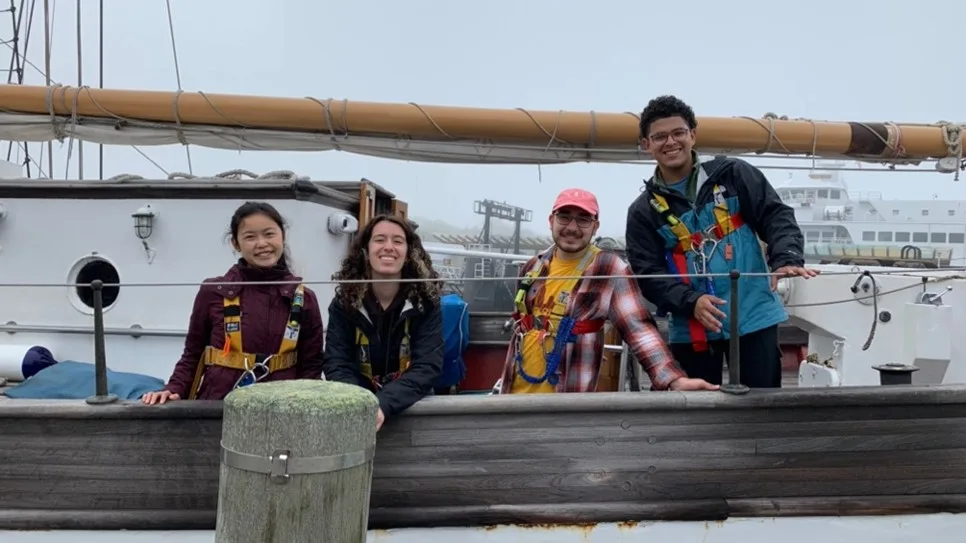Programs Blog
The Infinite Distance Glitch

Kly (Kluivert) Suquino
Ship’s Log
Noon Position: Woods Hole Dock
Ship Heading: N/A
Ship Speed: N/A
Taffrail Log (nm): N/A
Weather/Wind/Sail plan: Light Rain and Cloudy/ N/A/ Docked
Imagine that you are about to embark on a scientific journey through the North Atlantic. In order to complete this journey, you obviously have to travel some sort of distance. Before you can travel the distance entirely, you must first travel half of that distance. In order for you to travel half of that halved distance, you must travel half of that distance. To travel that doubly halved distance, you must travel half of that distance, and so on.
 Watches come together to weave friendship bracelets as the distance between us seems to become less and less infinite.
Watches come together to weave friendship bracelets as the distance between us seems to become less and less infinite.
Apparently, I overcomplicate this paradox when I try to describe it to my friends, leaving them in some frustration. I promise that by the end of this I will simplify it. Although, I can’t remember a time when a single scientist who said that they would try to simplify something actually simplified it.
So, basically, the amount of distance that we must travel on this voyage can be infinitesimally divided into smaller subunits. Thus, in order to complete the voyage, we must complete several small tasks, like traveling the half distance of a multi-halved unit, infinitely. This, in theory, is impossible, because by definition, we humans are incapable of the infinite.
My friends on this journey would say something like ‘but clearly this is not true because we are moving.’ The infinite distance glitch says no, and yes at the same time. If we are moving, then the distance can be divided as many times as possible—infinitely many times, if you will. Completing the smallest task, like traveling a fraction of the distance infinitely many times is impossible, by definition, because we would never be able to travel even the smallest subunit of distance, since the distance can be continually divided.
The only way that this distance we are traveling cannot be halved is to consider the first part of the voyage to consist of no distance—zero distance. If your goal is to move no distance at all, then the journey cannot be embarked in principle.
So, you say that the distance is not divided when we are moving, but this is true if we were not moving, but intuition tells us that we are moving regardless, which can both be regarded as true.
I say the distance is divided when we are moving, but this is true if we are moving, which means that we are actually not moving at all since traveling the infinite is impossible.
I’ll let your brain hurt for a minute.
My time at the Marine Biological Laboratory (MBL) in Woods Hole leading up to this voyage to the North Atlantic has been like the infinite distance glitch. It has been a game of completing several small and large tasks to learn and experience what this world has to offer. On this journey, you fall, you find people, you get back up, they fall, you help them get up too. This happens on that infinite loop, and you get to learn from each other while you embark on your separate journeys. On these infinitely long journeys, everyone has a unique aim in mind and sometimes, all you can do is be grateful that you impacted each other on your journeys and enjoy the ride.
The thing is, even though you feel the end nearing and the journeys veering off into the distance, the impacts of these journeys crossing over with each other don’t go anywhere. They help shape and mold our journeys, helping us to grow in a myriad of ways.
Even after feeling like I was so far away from everyone, my goals and my passions, it all could not have been more closely connected. Everyone that I have met because of my excitement for the natural world at the MBL is so important to my experience at the MBL and my journey to explore my passions.
After boarding the SSV Corwith Cramer, I questioned whether or not I could fully learn the capabilities of becoming a scientist, sailor or even a good crewmate. Having little experience in these avenues is nerve wracking and makes you wonder: where am I going with this? But when you put your trust in an excellent and professional team, tightly knit friends and your will to learn, where wouldn’t you be able to go?
So, the next time you are going somewhere, anywhere, remember that there is an infinite amount of distance to traverse. Sometimes, you have to take baby steps and sometimes you have to go for leaps. You might want to ask yourself where it is that you will end up. You can ponder the question, but maybe don’t.
Recent Posts from the Ships
- Ocean Classroom 2024-A collaborative high school program with Proctor Academy
- Collaborations and Long-term Commitments: SEA’s Caribbean Reef Program Sets a Course for Coastal Programs that Compliment Shipboard Experiences.
- Sea Education Association students prepare for life underway using state of the art nautical simulation from Wartsila Corporation.
- SEA Writer 2022, Magazines From the Summer SEA Quest Students
- Technology@SEA: Upgrades Allow Insight into Ocean Depths
Programs
- Gap Year
- Ocean Exploration
- High School
- Science at SEA
- SEA Expedition
- SEAScape
- Pre-College
- Proctor Ocean Classroom
- Protecting the Phoenix Islands
- SPICE
- Stanford@SEA
- Undergraduate
- Climate and Society
- Climate Change and Coastal Resilience
- Coral Reef Conservation
- Marine Biodiversity and Conservation
- MBL
- Ocean Exploration: Plastics
- Ocean Policy: Marine Protected Areas
- Oceans and Climate
- Pacific Reef Expedition
- The Global Ocean: Hawai'i
- The Global Ocean: New Zealand